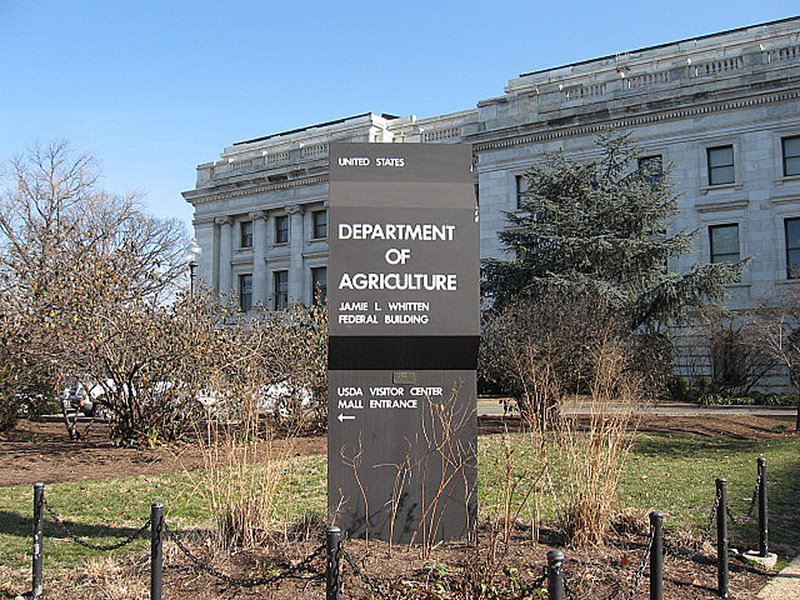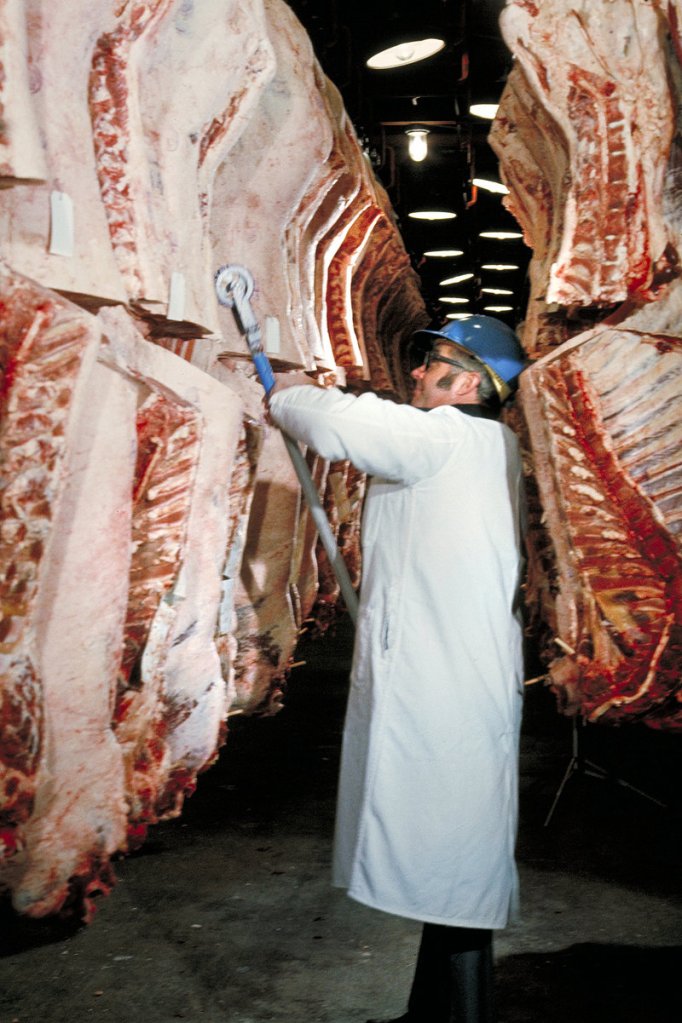The federal agency responsible for ensuring the safety of the nation’s beef supply has known for 14 years that retailers’ poor record keeping jeopardizes public health, but it failed to require better standards.
The U.S. Department of Agriculture blamed poor record keeping by Hannaford supermarkets for its failure to find the source of contaminated ground beef linked in December to a salmonella outbreak that sickened 20 people in seven states.
Yet the USDA knew as early as 1998, when it recommended the industry keep better “grinding logs,” that it was putting public health at risk by not requiring retailers like Hannaford to keep records that track the source of hamburger meat.
When a food-borne illness breaks out, identifying the source is critical to preventing more consumers down the line from getting sick. Grinding logs identify the various sources of meat that are sometimes combined to produce a single package of ground beef sold to consumers.
Even as the USDA heaped criticism on Hannaford for not having better record keeping practices, the agency has admitted that the grocery chain was not violating any federal rules.
The Hannaford case is now the poster child for why tough new record-keeping rules are needed, the federal agency acknowledges.
“There is a public health need to do what we can to expedite this rule making and that’s our focus right now,” said Daniel Engeljohn, an assistant administrator at the USDA’s Food Safety and Inspection Service, or FSIS.
Hannaford has changed its grinding log practices since the Dec. 15 beef recall, spokesman Michael Norton said.
Despite repeated inquiries by the Portland Press Herald, neither the USDA, the FSIS nor The Food Marketing Institute, which represents about 1,500 supermarkets and wholesalers, including Hannaford, would explain why a problem identified so clearly years earlier still had not been addressed.
And Richard Raymond, the under secretary for food safety at the USDA from 2005 to 2008, said in two recent interviews that he didn’t push to turn voluntary tracing standards into mandatory rules because it wasn’t on his “radar screen.”
GAPS IN THE FOOD SAFETY NETWORK
The federal Centers for Disease Control and Prevention estimates that about one in six Americans annually — about 48 million people — gets sick, 128,000 are hospitalized and 3,000 die of food-borne diseases.
The CDC’s 2011 estimate was that salmonella cases made up about one million of the 9.4 million cases involving known pathogens — 38.4 million cases involved unspecified pathogens. Those salmonella cases resulted in 19,336 hospitalizations and 378 deaths, the CDC estimated.
USDA officials agree that mandatory record-keeping rules would increase the safety of the nation’s food, although they stress that it’s not possible to guarantee 100 percent of the time that ground beef and other food will always be pathogen free.
Still, a 2009 USDA examination of food illness cases during 2007-2008 found that a number of “recent outbreak investigations were impeded by poor retail records.”
Of 16 ground beef contamination investigations at the retail level, just nine retailers kept adequate grind logs “sufficient for trace back and trace forward activities,” the USDA said.
Research published last year in the Journal of Food Protection found that in a survey of 125 grocery stores, only 61 stores, or 49 percent of the sample, kept grinding logs. Of the 179 grinding logs reviewed at those stores, only 39 logs, or 22 percent, included enough information to allow investigators to trace contaminated meat back to its source.
USDA KNEW ABOUT THE PROBLEM
The USDA first issued recommendations in 1998 for the best way to keep a grinding log, but that federal “guidance” is completely voluntary and different grocers and other retailers can make up their own rules and standards.
“We’re doing more than what’s required and were before (the recall,)” Hannaford’s Norton said.
The USDA has done little but talk about the problem of inadequate grinding logs, but the Hannaford case is a big reason why talk finally may be turning to action. A detailed proposal for those rules could be released this summer, though it likely will take months or years to put final rules into effect.
“The Hannaford recall caused a shift,” said Tony Corbo, a lobbyist for Food and Water Watch, a Washington D.C.-based nonprofit advocacy group. Federal officials were “talking about it before, but this wound up being a big warning sign that they needed to take action.”
Since 1998, there have been 225 recalls of ground beef, a number that includes recalls at wholesalers and other food service entities in addition to retailers like Hannaford.
A top federal food safety official was crystal clear in December 2009 about the public health need for the government to require retailers to keep better meat grinding records.
“We often don’t have all the information we need to protect public health,” said Jerold Mande, then the USDA’s acting under secretary for food safety, at a public food safety meeting in Washington.
For instance, the agency’s Food Safety and Inspection Service couldn’t track the source of contaminated ground beef from one retailer that was linked to an E. coli outbreak in Kentucky in 2008 because of inadequate records.
That means consumers had no way of knowing when they walked into their local supermarket whether that same contaminated beef was on the shelves, since it had never been traced back to the original source.
“The retailer acknowledged it produced several beef grinds but did not maintain the grinding logs,” Mande said. “If we had been able to identify the source or sources, we could have determined if other contaminated meat still remained in commerce. Doing so would have prevented other consumers from getting sick, enabled us to determine whether plants were still producing contaminated product, and allowed us to verify if corrective actions were working.”
DELAYS AT THE USDA
But why has it taken so long to put a grinding log mandate in place once the USDA decided that was needed?
The USDA wouldn’t directly address that question. All the agency will say is that it hopes to release a detailed proposed rule by this summer.
“FSIS is developing a grinding log proposed rule that would close existing gaps in record keeping, improve safeguards and address other concerns that surfaced during the Hannaford recall,” the USDA said in a statement released to the Portland Press Herald on March 5. “Until a rule is in place, FSIS is encouraging the industry to comply with best practice guidelines, and will provide technical assistance to increase voluntary compliance with these guidelines to prevent food-borne illness.”
But the Hannaford case is fresh evidence that too many retailers won’t adopt stringent enough rules voluntarily, Engeljohn acknowledged.
“This isn’t as a direct consequence of Hannaford that this rule making’s coming forward, but it is evidence that industry-wide there has not been good adoption of the best practices guidance that we have put out there,” Engeljohn said. “Because we’ve identified this issue about inadequate grinding logs and record keeping being maintained, particularly at retail, … it’s time to take a regulatory action to put in place more stringent regulatory requirements for grinding log records associated with ground beef.”
RETAILERS: ONE SIZE DOES NOT FIT ALL
The Food Marketing Institute says it is working with the USDA to agree on a “workable” mandate but won’t commit to what a tougher set of rules would look like.
“We’re extremely interested and engaged in identifying a workable rule with USDA,” said Hilary Thesmar, FMI’s vice president of food safety programs, via email.
The industry group says it remains up to individual retailers to decide how to keep their own records, and that no voluntary, industry-wide standards have been adopted that all retailers uniformly follow.
The institute wouldn’t address directly the question of why it has taken so long to accomplish that goal, but the trade group indicated it doesn’t agree that all stores should follow the same rules.
“Retailers have differing solutions to keep track of their grind logs,” Thesmar said. “It’s difficult to impose a one-size-fits-all standard.”
FMI has been talking since 2008 with the USDA’s Food Safety and Inspection Service about “how retailers can maintain full grinding logs that are both workable for store management and for the good of public health,” Thesmar said.
Advocate Corbo has a different explanation of why many retailers might balk at a federal mandate: money.
“It would cost more money to set up proper record keeping– not only the design, but the cost of labor to record the information,” Corbo said.
However, the American Meat Institute, a lobbying group representing slaughterhouses and meat-packing plants, wants to see grinding logs required at the retail level.
“We are on the record for supporting those kind of manufacturers’ logs,” said Scott Goltry, American Meat Institute’s vice president in charge of food safety and inspection issues.
RULE NOT A PRIORITY DURING BUSH YEARS
Raymond, the under secretary for food safety during the second George W. Bush administration, said the food industry generally opposes any new regulation.
Raymond said he spent much of his time at USDA pursuing, without success, a requirement that agency meat plant inspectors pursue a “risk-based system” that would have them spend more time at plants with bad safety records and at plants that produced higher risk products such as raw ground beef.
But Raymond said he didn’t push to turn voluntary grind log and tracing standards into mandatory rules during his tenure. Raymond said he believed that most retailers followed federal recommendations, and he said that in the Republican Bush administration the emphasis was on less, not more, regulation.
Asked about instances during his time at USDA when insufficient retail records prevented the source of an outbreak from being found, Raymond said that while he was aware of the grind log issue, “it was not high on my radar screen.”
In a big universe of food safety problems he was trying to address, inconsistent grind log practices didn’t rise to the level of an urgent problem that needed federal regulation, and he does not recall whether he was ever presented with a request from USDA staff to do so, Raymond said.
“I did not feel it was a significant public health risk compared to other food safety issues,” Raymond said.
Still, Raymond called the Hannaford case an example of a “bad problem” caused by inadequate records.
HANNAFORD ALTERS GRINDING PRACTICES
Before the outbreak, Hannaford maintained grinding logs for most, but not all, of the beef ground in the store. Eighty percent of the ground beef they sell arrives pre-ground from one of the company’s dozen beef suppliers — the in-store butcher just fine-grinds it before packaging it for sale. But about 20 percent of Hannaford’s ground beef comes from “trim,” the leftover meat in-store butchers carve off of larger cuts of meat.
Once a day, Hannaford stores would take all that leftover trim and grind it — but there was no “log” tracking the source of every bit of that meat, since it came from multiple cuts received from multiple processors.
The same day Hannaford announced the recall, the company ordered its butchers to stop grinding trim and to start throwing it away. But since then, Hannaford has developed a more detailed record-keeping system designed to show exactly what pieces of meat go into every package of ground beef. Trim is still ground, Norton said, because it is good, certified meat, but now Hannaford knows the source of every piece of trim in each package of ground beef.
“We now record all source materials used to generate in-store ground beef.”
The supermarket is also cleaning and sanitizing its meat-grinding equipment more frequently, Norton said.
LEGAL LIABILITY
Drew Falkenstein, an attorney with Marler Clark in Seattle and author of the Food Poison Journal blog, said Hannaford’s incomplete grinding logs exposed the company to legal liability.
“If Hannaford could show who supplied them with the contaminated ground beef, they could do what’s called a crossclaim and sue another entity,” Falkenstein said.
Marler Clark is in the midst of investigating whether several potential clients were sickened by beef sold at Hannaford stores.
A mandatory grind log rule would be a logical step that would safeguard retailers, Falkenstein said.
“I really don’t know why” it has taken so long to put the rule in place, Falkenstein said. “Rule making is a long and complex process, you might say. But the cynic in me might say that the USDA is at least somewhat affected by industry opinion and industry desire on issues like this.”
Sarah Klein, a staff attorney with the nonprofit Center for Science in the Public Interest in Washington, D.C., and a food safety expert, said when the USDA launches an investigation into a contamination outbreak or works on new mandates such as better beef grinding records, there is a built-in conflict at work.
“The USDA has always had this tension between wanting to serve two masters in their responsibility to promote U.S. agriculture and in their public health responsibility to police U.S. agriculture,” Klein said. “It is difficult for the agency to talk about what the potential sources of contamination are without bad mouthing, for lack of a better word, some producers, suppliers or vendors who may end up being blameless. It is particularly difficult for the agency to do that given its responsibility to promote these same vendors and producers.”
NEW REGULATIONS TAKE TIME
It can take months or even years to put a new rule in place, no matter how simple or straightforward the rule might seem, Raymond said.
The rule making process will begin when the USDA comes out with a specific proposed rule this summer that it sends for review to the White House Office of Management and Budget. OMB’s review, which includes looking at whether the rule’s cost to industry and the public is worth the benefits, typically takes about 90 days.
If OMB clears the rule, it is then published as a proposed rule in the Federal Register and is open for public comment, giving industry and advocates and the general public the chance to weigh in on whether the rule is too burdensome or too lax.
After the public comment period, which generally is about two months, the agency will assess whether any substantive objections were raised. If not, a draft final rule is developed and the entire review and clearance process is repeated within the USDA and OMB, with no set time frame.
Even after a rule is adopted there likely will be time allotted for all retailers to comply. In all, months or even years still might go by before a grind log rule is actually in effect.
“The average time to create a rule, write it and put it through the process and get it into action is about three years, two years minimum if there is no controversy,” Raymond said. “The American process is to give everyone the ability to have their say.”
Washington Bureau Chief Jonathan Riskind can be contacted at 791-6280 or at:
jriskind@mainetoday.com
Twitter: MaineTodayDC
Staff Writer Avery Yale Kamila can be contacted at 791-6297 or at:
akamila@pressherald.com
Twitter: AveryYaleKamila
Send questions/comments to the editors.





Success. Please wait for the page to reload. If the page does not reload within 5 seconds, please refresh the page.
Enter your email and password to access comments.
Hi, to comment on stories you must . This profile is in addition to your subscription and website login.
Already have a commenting profile? .
Invalid username/password.
Please check your email to confirm and complete your registration.
Only subscribers are eligible to post comments. Please subscribe or login first for digital access. Here’s why.
Use the form below to reset your password. When you've submitted your account email, we will send an email with a reset code.